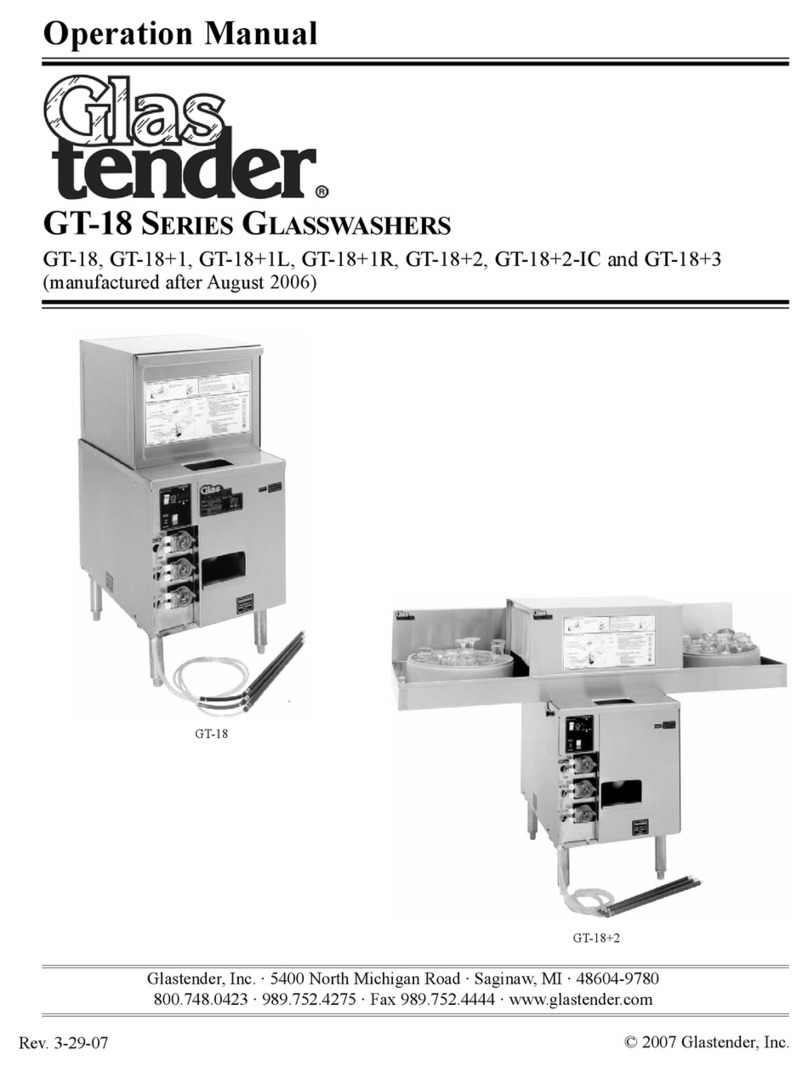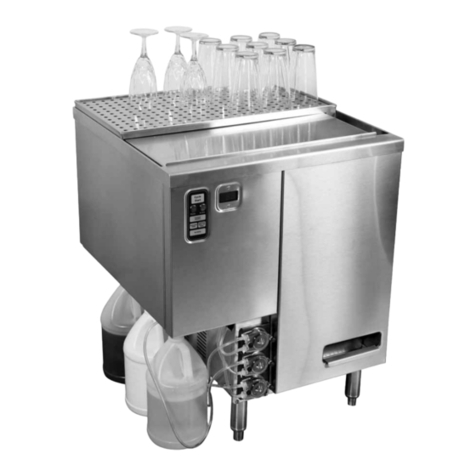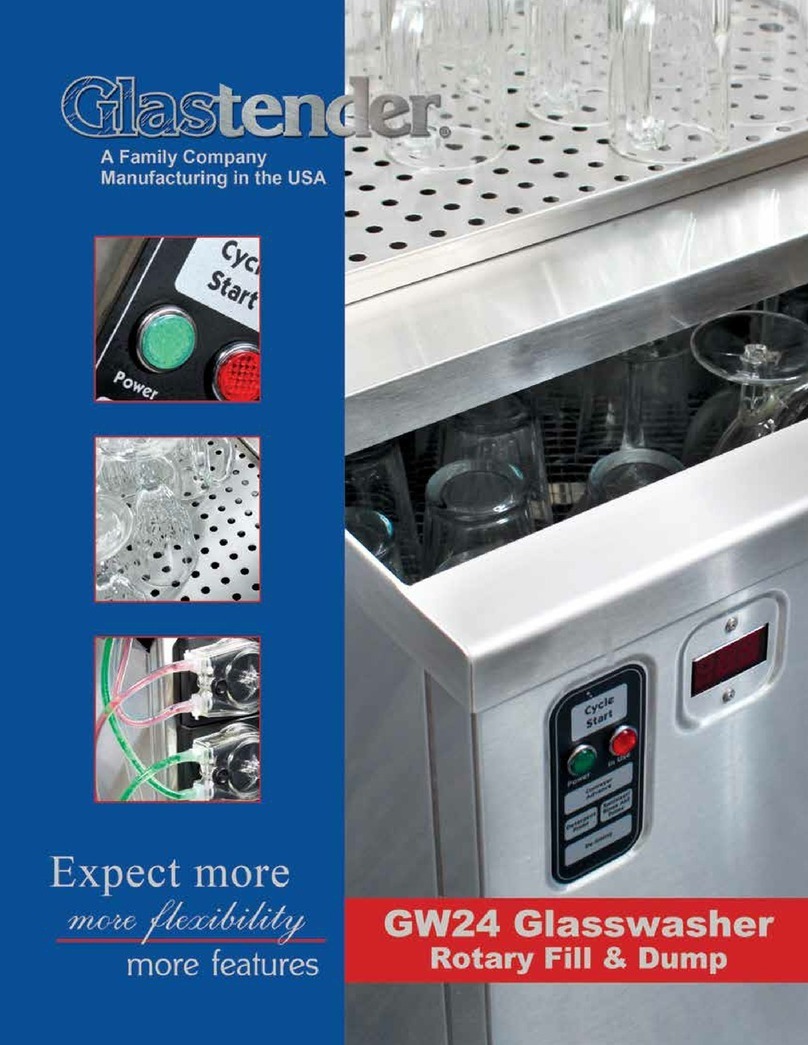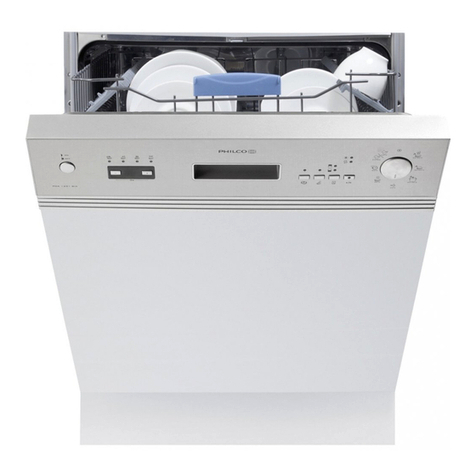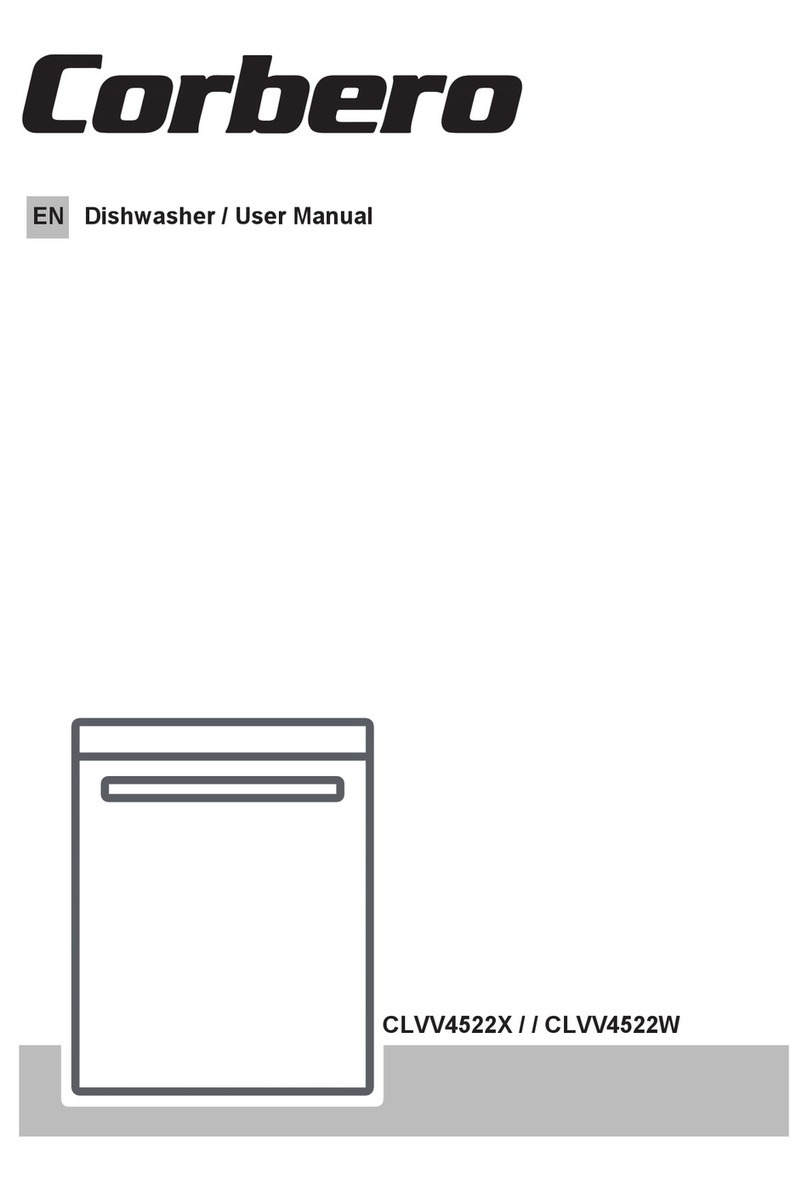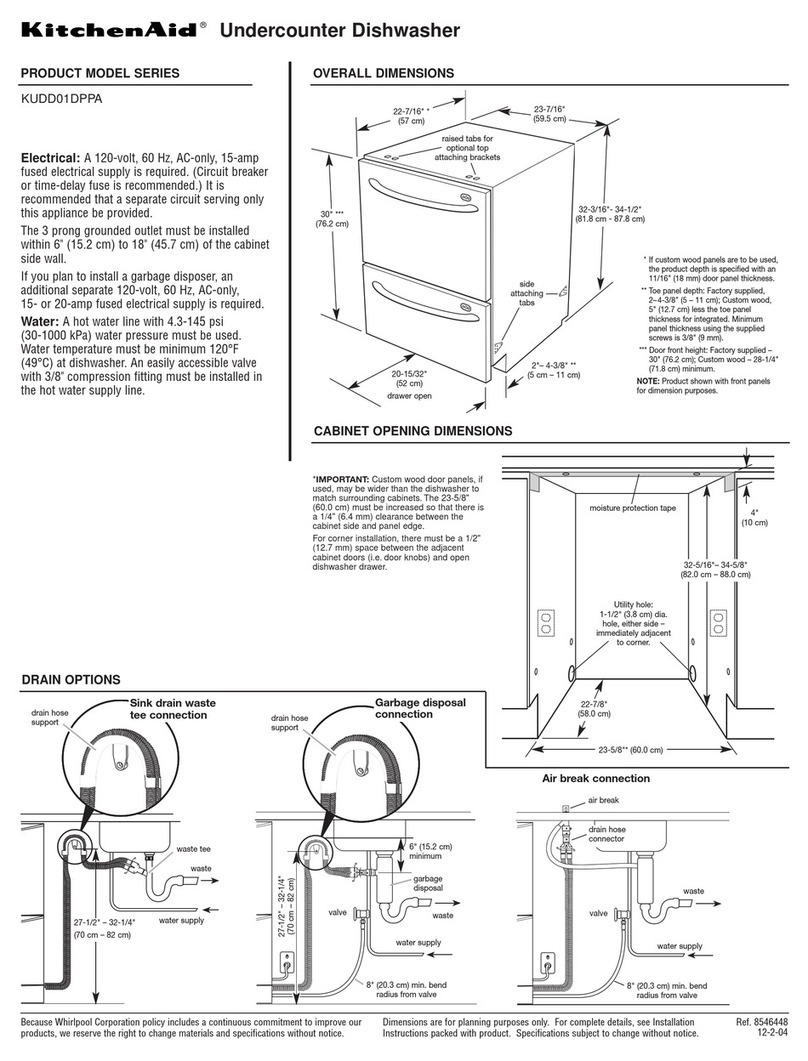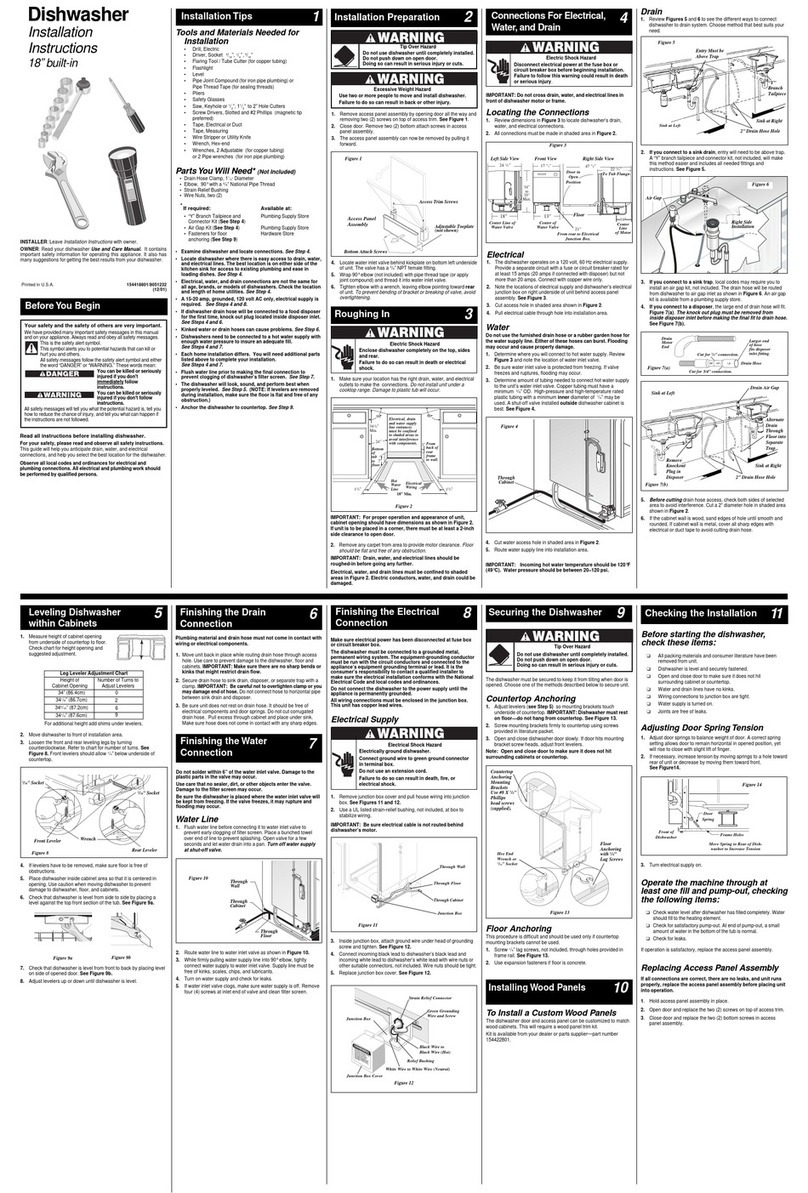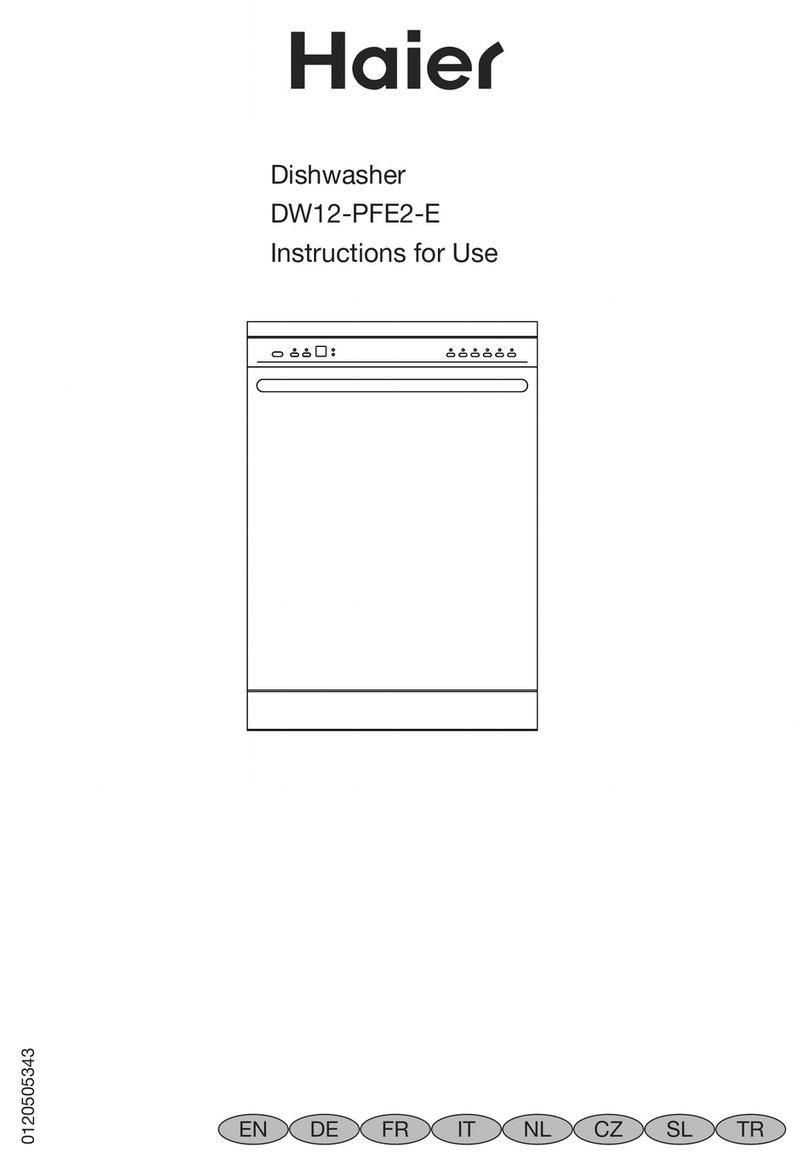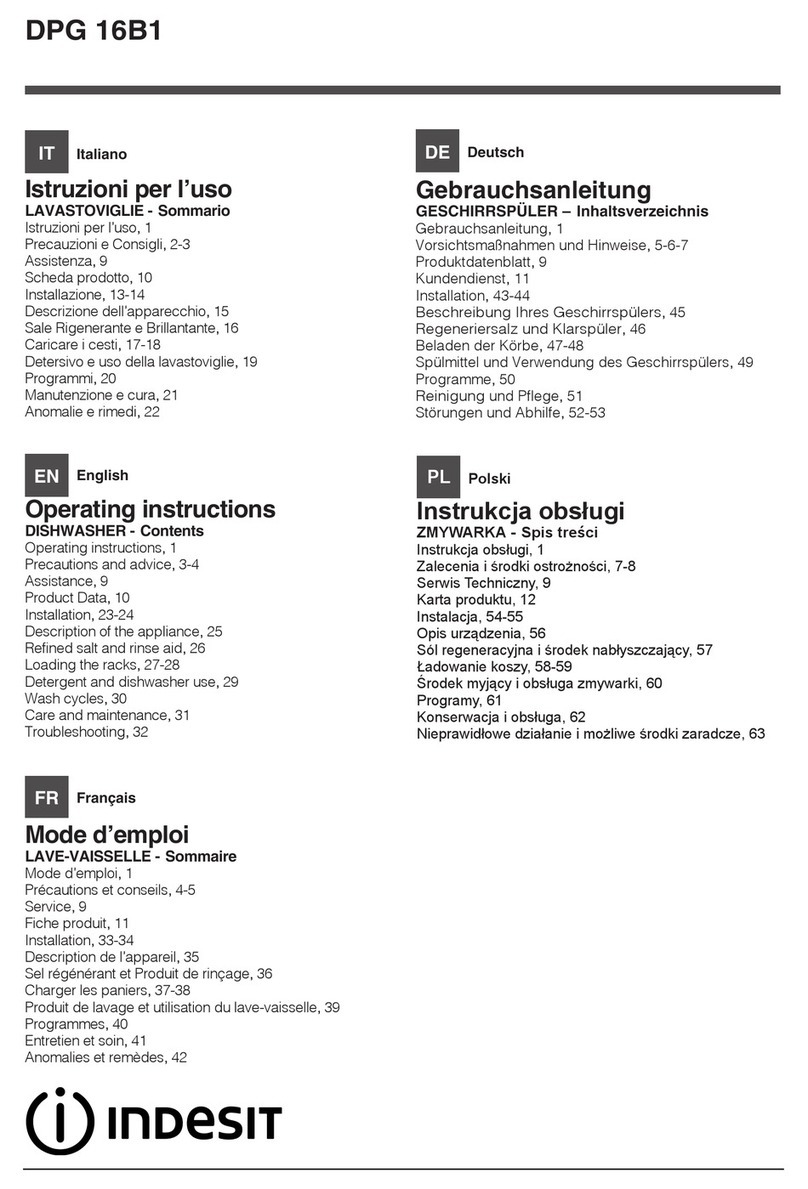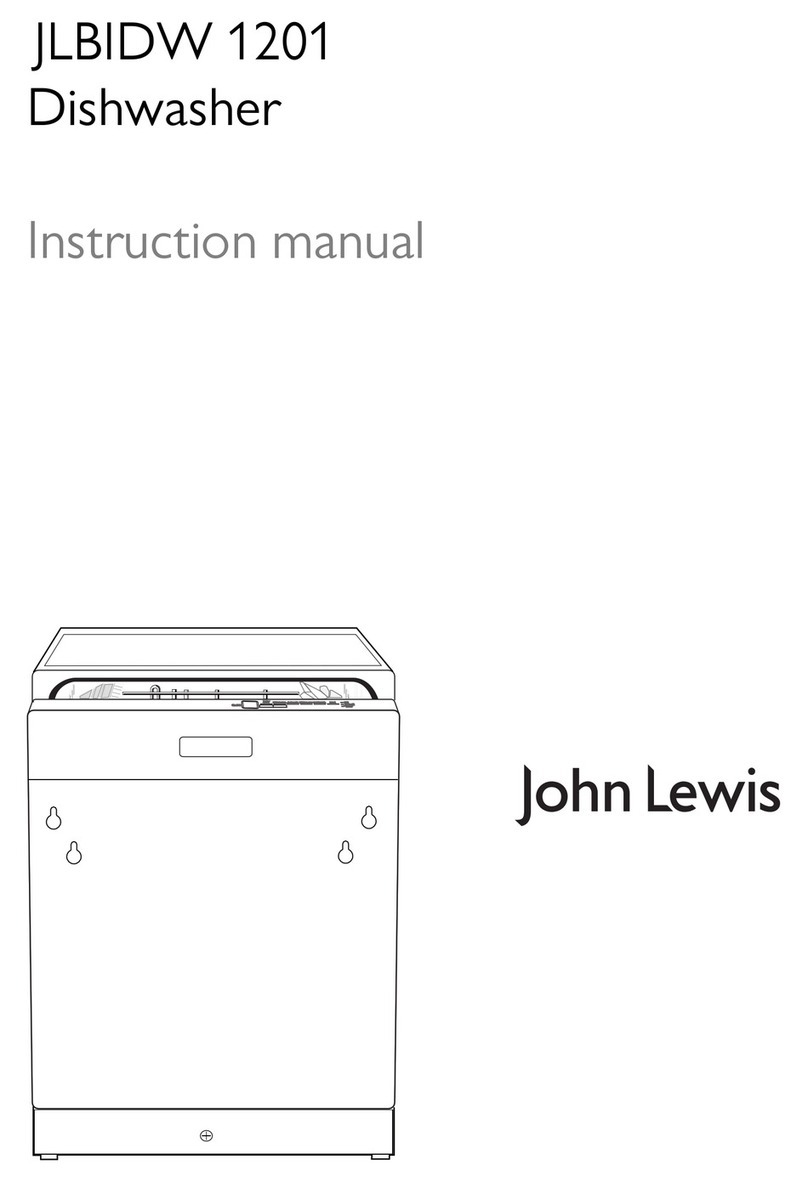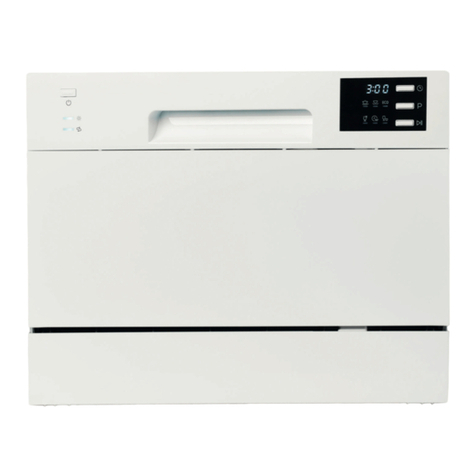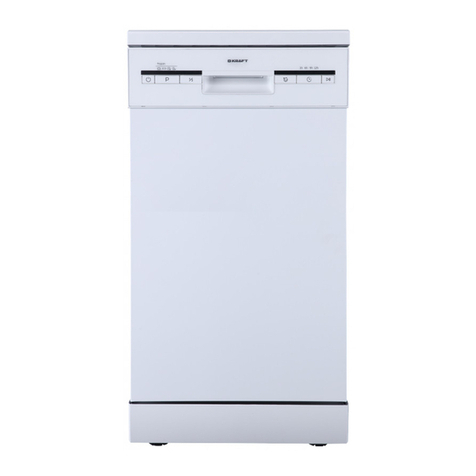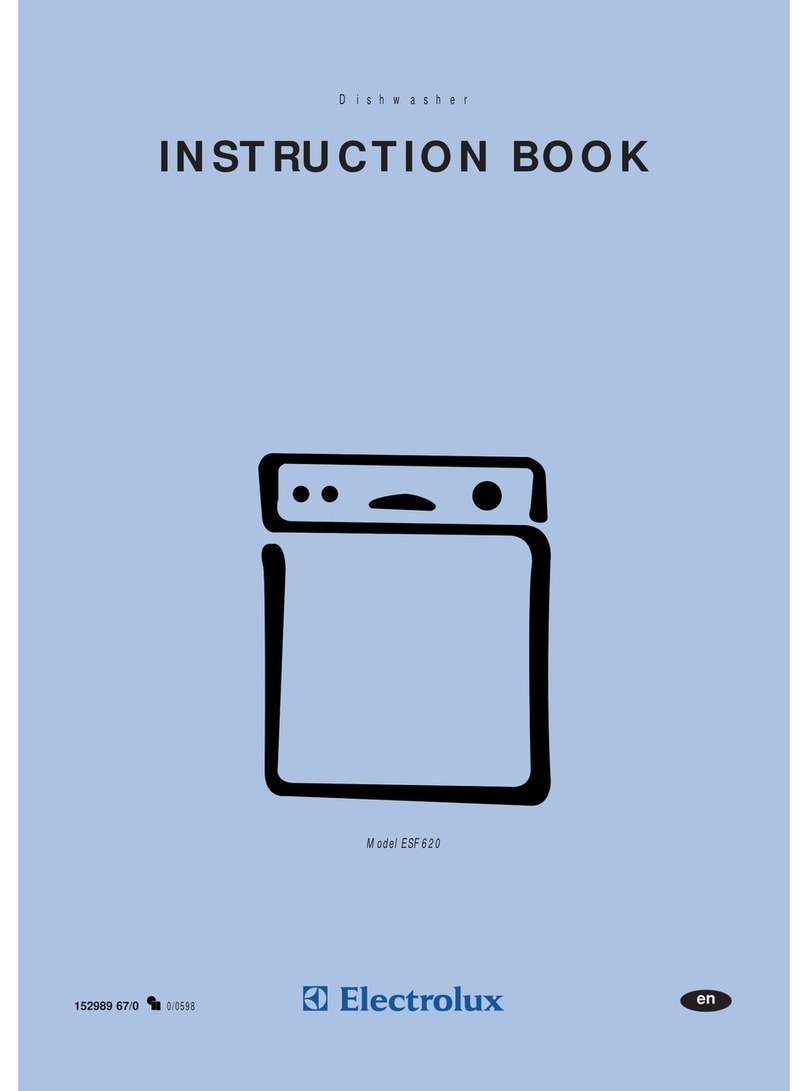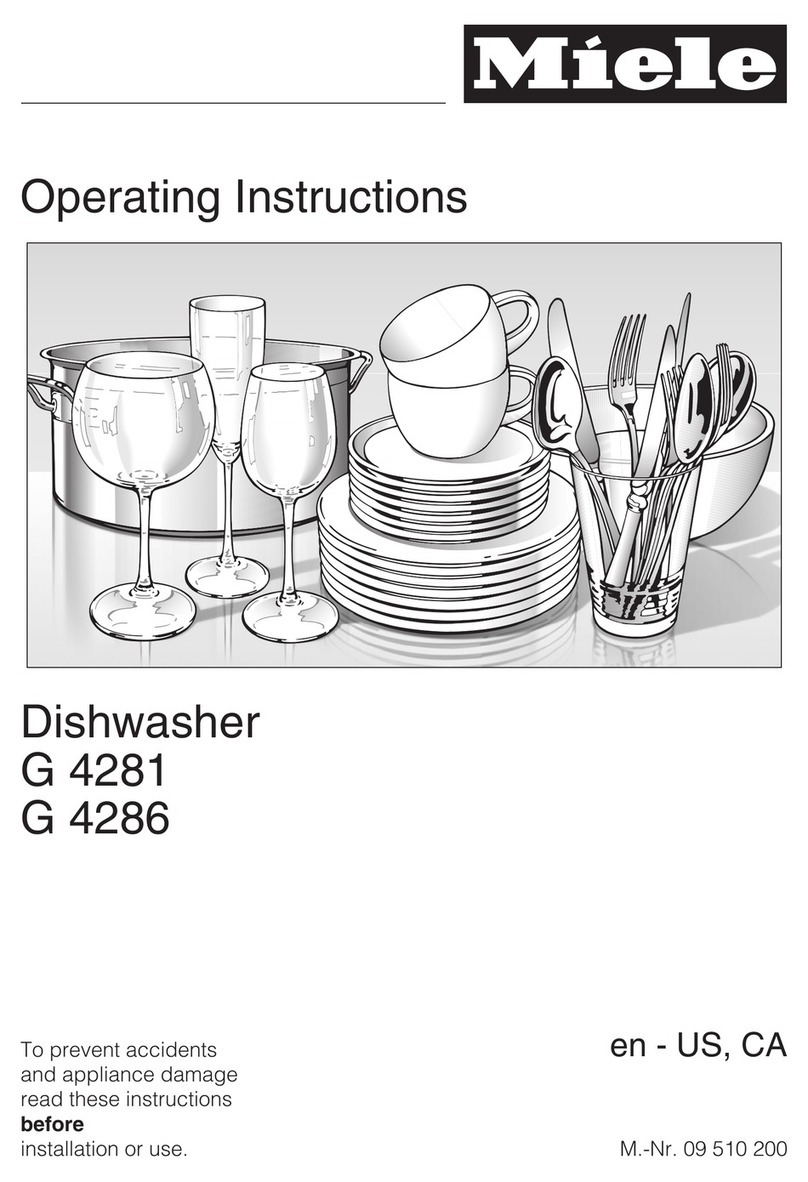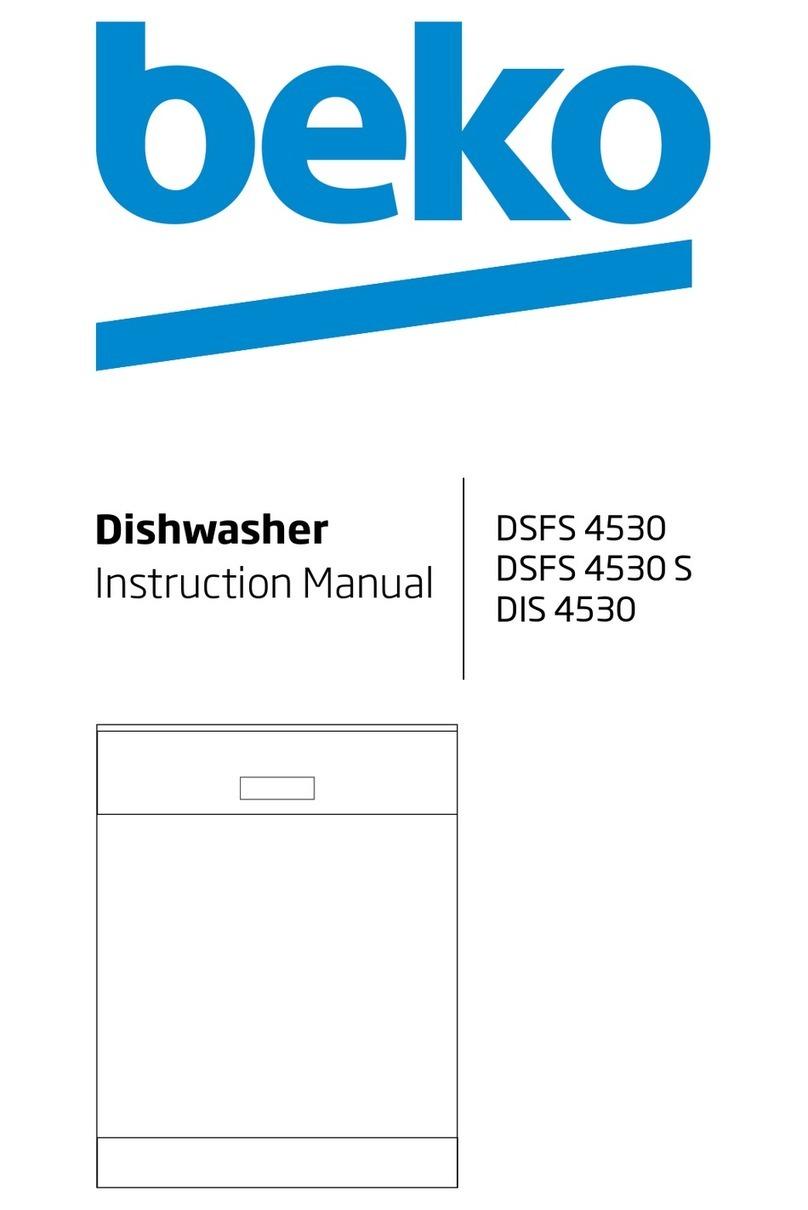Glastender GT-24 User manual

GT-24-CW
GT-30-CCW
Operation Manual
GT-24, GT-30
Glasswashers
Glastender, Inc. · North Michigan Road · Saginaw, MI · 48604-9780
800.748.0423 · 989.752.4275 · Fax 989.752.4444 · www.glastender.com
© 2007 Glastender, Inc.
Rev. 11-13-07


Glastender, Inc. • 5400 North Michigan Road • Saginaw, MI • 48604-9780
800.748.0423 • 989.752.4275 • Fax 989.752.4444 • www.glastender.com 1
Topic Page
Warranty.................................................................................................................... 1
What is a glasswasher? ............................................................................................. 2
Uncrating Instructions and Equipment Checklist..................................................... 3
Main Section - Top View.......................................................................................... 4
Wiring Diagrams
Manufactured Before Jan. 2003 ...................................................................... 5
Manufactured After Jan. 2003 ......................................................................... 6
Utility Requirements and Connections..................................................................7-8
Start-Up Instructions..............................................................................................8-9
Peristaltic Pump Adjustments .............................................................................. 9-10
Useful Information About Water, Detergent and Sanitizer .................................... 11
How to Operate the Glasswasher ........................................................................... 12
How the Glasswasher Operates .........................................................................12-14
Tips for Trouble-Free Operation............................................................................. 14
Important Information About Chemicals................................................................ 15
Diagnosing Poor Wash Results............................................................................... 16
Cleaning Instructions .........................................................................................17-18
Troubleshooting Guide ......................................................................................19-21
Index
IMPORTANT!!
Attention Refrigeration Service Companies
Please review the important warranty information on this page. If you believe a
service call should be covered by the factory, please call the factory for authorization
between 8AM and 5PM EST, Monday through Friday.
warranty statement
LABOR: Glastender, Inc. warrants all products to be free of defects in
material and workmanship. In established areas, a start-up and a 90-
day labor warranty are included with glasswasher models GT-24 and
GT-30. The GT-18 series glasswashers include a 90-day labor warranty.
Self-contained refrigeration models, except beer line chillers, include a
1-year labor warranty, for the duration of one year from date of instal-
lation or up to 18 months from date of factory shipment, whichever
occurs sooner. For warranty labor claims beyond 15 months from the
date of factory shipment, proof of date of installation or occupancy must
be provided. Authorization for labor must be obtained from Glastender
within the warranty period and prior to the service being performed.
Labor warranty applies to the United States and Canada only.
PARTS: Within one year from date of installation, or 15 months from
date of factory shipment, whichever occurs sooner, Glastender, Inc.
will replace any part or assembly found defective under normal use and
service. Field replacement parts include a warranty of 90 days from date
of installation. All self-contained refrigeration models include a 5-year
compressor warranty.
A warranty claim form MUST accompany all returned defective parts or
assemblies. This form MUST be completed in full. Failure to do so may
result in delay or denial of credit. Any defective part or assembly must
be returned to Glastender, Inc., Saginaw, Michigan, with all transporta-
tion and delivery charges prepaid. Warranty repairs or replacements will
be shipped FOB factory in Saginaw, Michigan.
The warranty does not cover equipment subjected to accidents, freight
damage, alterations, improper power and/or plumbing hookups, improp-
er chemical use, general misuse, or lack of routine required maintenance
as determined by Glastender, Inc.
No representative, distributor, dealer, or any other person is authorized
to modify this warranty. This warranty replaces all other written or
verbal warranties.
NOTE: Glastender, Inc.’s policy of constant quality improvement
means that prices, specifications, and policies are subject to change
without notice. Questions regarding this warranty should be directed to
Glastender’s Customer Service Representative.
03/01/07

Glastender, Inc. • 5400 North Michigan Road • Saginaw, MI • 48604-9780
800.748.0423 • 989.752.4275 • Fax 989.752.4444 • www.glastender.com
2
This manual describes the operational features of the GT-24 and GT-30 model glasswashers with digital tempera-
ture gauges. Please review this information before attempting installation and operation.
Long term, trouble-free operation will follow if good housekeeping and maintenance procedures are followed.
Thank you for selecting Glastender, Inc. products.
IntroductIon
Glastender, Inc. manufactured the original automatic, rotary glasswasher in 1969. Today, Glastender glasswash-
ers have been installed around the world.
But what is a glasswasher? It is simply a piece of machinery that washes glassware, which eliminates the need
for human labor and the conventional three-compartment sink. The glasswasher is, in effect, a mechanized three-
compartment sink. It “washes”, “rinses”, and “sanitizes” glassware.
wash Hot water and a preset portion of detergent join in the Wash Tank. Operating temperature
is maintained between 130ºF (54ºC) and 150ºF (66ºC) by a stainless steel heater, and the
proper water level is maintained with a liquid level control. During operation, 5 gallons
per minute of hot soapy water are pumped in a forceful, but gentle, spray pattern across
the moving glassware. This entire wash compartment is isolated by curtains, and the
wash water is recirculated to conserve water and detergent. Actual hot water consumption
during operation is ¼ gallon per minute.
rInse and
sanItIze
Cold water and a preset portion of sanitizer join in the sanitizing compartment called the
Rinse Tank. The proper water level is maintained with a liquid level control. During
operation, 2 gallons per minute of cold rinse water are pumped in a forceful, but gentle,
spray pattern across the moving glassware and down the drain. The unique pumped rinse
feature ensures a consistent, thorough rinse.
Please read on to learn more about this simple machine.
note the sImplIcIty:
FunctIon desIGn
what Is aGlasswasher?

Glastender, Inc. • 5400 North Michigan Road • Saginaw, MI • 48604-9780
800.748.0423 • 989.752.4275 • Fax 989.752.4444 • www.glastender.com 3
The glasswasher is shipped in one carton. Please refer to Figure 1 and locate the following items:
the Items are:
assembly
order descrIptIon
1 Bolt the legs to the base of
the Main Section.
2 Remove all packaging from
the Main Section.
3 Remove plastic protective
paper from all stainless steel
parts. This may require
removing side panels.
4 Place glasswasher in position
and level by adjusting the bot-
tom portion of the stainless legs.
5 Make plumbing and electrical
connections (see page 8).
assembly procedures:
Item
number descrIptIon
1 Main Section
2 Stainless Steel legs (4)
3 Conveyor
4 Front Curtain
5 Wash Curtain
6 Rinse Curtain
7 Front Shield
8 Top Section
note:Figure 1 shows a clockwise model with front switch panel.
FIGure 1
uncratInG InstructIons and equIpment checklIst
2
1
4
3
5
8
7
6

Glastender, Inc. • 5400 North Michigan Road • Saginaw, MI • 48604-9780
800.748.0423 • 989.752.4275 • Fax 989.752.4444 • www.glastender.com
4
Item
number descrIptIon
1 Glass Stop Arm
2 Drain Plug (2 required)
3 Pump Inlet Screen (2 required) - One pump inlet screen is in the rinse tank hidden from
view below the rinse tank guide.
4 Heater
5 Spray Box Cam Lock
6 Wash Tank Liquid Control and Low Level Pickup Tube - The rinse tank liquid control
and low level pickup tube is hidden from view by the rinse tank pickup tube cover.
7 Detergent Inlet Tube
8 Hot Water Inlet and Air Gap (in side wall) - Pickup tube cover has been removed for
illustrative purposes.
9 Wash Tank
10 Wash Spray Box
11 Rinse Tank
12 Rinse Tank Pickup Tube Cover - The cold water inlet and sanitizer inlet tube are under-
neath the cover
13 Conveyor Drive Shaft
14 Rinse Spray Box
15 Rinse Tank Guide
16 Drain Tank with Drain Screen
Please familiarize yourself with the following parts:
note:Figure 2 shows a model GT-24 with clockwise conveyor movement. Counterclockwise
conveyor movement models have identical parts in reverse positions.
16
15
14
2
4
7
6
5
9
13
12
810 11
FIGure 2
maIn sectIon - top VIew
1
3

Glastender, Inc. • 5400 North Michigan Road • Saginaw, MI • 48604-9780
800.748.0423 • 989.752.4275 • Fax 989.752.4444 • www.glastender.com 5
wIrInG dIaGram unIts beFore Jan. 2003
Cold Water
Inlet Valve
Hot Water
Inlet Valve
Transformer
(24 VAC Secondary)
W/R(16 AWG)
R(20 AWG)
W/R(16 AWG)
R(12 AWG)
"Check Chemical" Light on Switch Panel
B(12 AWG)
W/R(16 AWG)
W/R
W
Field Connection Box
W
B
R
Ground
W
G
Fill Switch
P
P
W
On-Off
P
Br
Bl
Wash
Pressure Switch
W
C
NC
NO
P
P
G
P
On-Off
P
P
Conveyor Switch
G
G
P O
Rinse
Pressure Switch
Glass Stop Switch
C
C NC
NC
W
120/208V or 120/240V, Single Phase
60Hz, 3 Wire, 20 Amp. All wires
are 16 Gauge unless marked
otherwise. Wire Temperature Rating
Wash Recirculating Pump Motor
Rinse Recirculating Pump Motor
ELECTRICAL RATINGS
Display
Temperature
Temperature
Display
NC
NO
NC
C
Detergent Empty Sensor
Pressure Switch
W/B(20 AWG)
W/B(20 AWG)
Rinse
Wash
W/B(20 AWG)
W/B(20 AWG)
C
Sanitizer Empty Sensor
Pressure Switch
C
R
Detergent Pump Motor
Cold Water Solenoid
Hot Water Solenoid
Relay
Heating Element
Conveyor(Gear)Motor
Sanitizer Pump Motor
Power Light
R
R(12 AWG)
B
B(12 AWG)
equals 105 C.o
-85mA
-85mA
-63mA
-160mA
-208V or 240V,4KW
-1/12 HP,2.7A
-1/12 HP,2.7A
-1/140 HP,0.48A
-160mA
W/O = White W/Orange
W/Br = White W/Brown
W/R = White W/Red
W/B = White W/Black
W/Bl = White W/Blue
W/G = White W/Green
W
WW
Detergent Prime Switch
Sanitizer Prime Switch
24V
AC
AC
24V
Detergent Pump Transformer
Thermostat
(24 VAC Secondary)
WW
Br
Bl
P
Bl
B
R
Sanitizer Pump Transformer
Rinse Water
W
(24 VAC Secondary)
Recircu-
lating
PumpPump
lating
Recircu-
Wash Water
Y Y
G
W
B B
O O
Conveyor
Motor
W
B
R
LEGEND
3
Detergent P.C. Board
2
1
Heating Element
Coil
Relay
R(12 AWG)
B(12 AWG)
W/Br(20 AWG)
W/Br(20 AWG)
B(20 AWG)
R(20 AWG)
W/Br W/Br
4
W
W
BR
B = Black
Bl = Blue
Br = Brown
G = Green
O = Orange
P = Purple
R = Red
W = White
Y = Yellow
3
Sanitizer P.C. Board
W
W
12
W
W/O(20 AWG)
W/O(20 AWG)
B(20 AWG)
R(20 AWG)
W/O
W/0
B
B
24VDC Sanitizer Pump Motor
24VDC Detergent Pump Motor
4
W
BR
WW

Glastender, Inc. • 5400 North Michigan Road • Saginaw, MI • 48604-9780
800.748.0423 • 989.752.4275 • Fax 989.752.4444 • www.glastender.com
6
wIrInG dIaGram unIts aFter Jan. 2003
Conveyor
Motor
Rinse Water
Recircu-
lating
Pump
Pump
lating
Recircu-
Wash Water
Y Y
GG
W W
W
W
B B
B
BW
W
Y
G
G
G
P
P
OO
Cold Water
Inlet Valve
Rinse
Pressure Switch
Glass Stop Switch
On-Off
P
P
W
W
W
W
Hot Water
Inlet Valve
Br
Bl
Bl Bl
Thermostat
Wash
Pressure Switch
Fill Switch
P
P
W
C
C
C NC
NC
NC
NO
Heating Element
Coil
Power Light
Relay
W
W
R
R(10 AWG)
B
B(10 AWG)
R(10 AWG)
B(10 AWG)
W
W
W
Detergent Prime Switch Sanitizer Prime Switch
24V
AC AC
24V
NC
NO
NC
C
Detergent Empty Sensor
Pressure Switch
"Check Chemical" Light on Switch Panel
B
R
B(10 AWG)
R(10 AWG)
R/W(16 AWG)
Br/W(20 AWG)
O/W(20 AWG)
On-Off
Conveyor Switch
Ground
Display
Temperature
Temperature
Display
24VDC Sanitizer Pump Motor
24VDC Detergent Pump Motor
Field Connection Box
Rinse Wash
R(20 AWG)
R/W(16 AWG)
P
C
Sanitizer Empty Sensor
Pressure Switch
C
R/W(16 AWG)
R R
R
O
Br
P
P PP
Sanitizer / Detergent
Speed Control
Module
O/W O/W
Br/W
P
O/W(20 AWG)
Br/W(20 AWG)
Br/W
-208V or 240V,4KW
-1/12 HP,2.7A
-1/12 HP,2.7A
-1/140 HP,0.48A
are 16 Gauge unless marked
equals 105 C.
otherwise. Wire Temperature Rating
Conveyor(Gear)Motor
Cold Water Solenoid
Hot Water Solenoid
Heating Element
Sanitizer Pump Motor
Detergent Pump Motor
Rinse Recirculating Pump Motor
Wash Recirculating Pump Motor
ELECTRICAL RATINGS
Relay
o
-85mA
-63mA
-85mA
-160mA
-160mA
120/208V or 120/240V, Single Phase
O/W = Orange W/White
R/W = Red W/White
60Hz, 3 Wire, 20 Amp. All wires
Br/W = Brown W/White
R = Red
Bl = Blue
P = Purple
O = Orange
G = Green
Br = Brown
B = Black
LEGEND
Y = Yellow
W = White
O
OO
Br
R+ B-
R+ B-
R+ B-
8 + - 10
12 11
1
2
5 6 1413
Speed Control
Potentiometers
SAN
DET
7 + - 9
WB
WB

Glastender, Inc. • 5400 North Michigan Road • Saginaw, MI • 48604-9780
800.748.0423 • 989.752.4275 • Fax 989.752.4444 • www.glastender.com 7
1. General Plumbing................. a. Use 3/8” O.D. copper to 3/8” FMPT adapter provided.
(Hot water and cold.............. b. Minimum water pressure - 25 psi.
water required) ..................... c. Maximum water pressure - 100 psi. Install water pressure regulator if line
.............................................. pressure is over 100 psi. Water valve on unit has built-in line strainer and
.............................................. flow control to provide consistent volume between 25 psi and 100 psi.
.............................................. d. Install separate water shut-off valve for each connection.
.............................................. e. The unit has built-in air gaps. Vacuum breakers are NOT required.
2. Hot Water Only .................... a. Maximum temperature 150° F (66° C). Minimum temperature 130° F (54° C).
.............................................. b. Initial fill 3.00 gallons (GT-24) or 3.50 gallons (GT-30).
.............................................. c. Consumption - 1/4 gallon per minute during operation.
3. Cold Water Only................... a. Minimum temperature is 75° F (24° C) per FDA Ordinance and Code for
Food Service Establishments, Section 5-103(e)(2). Install hot/cold water
mixing valve if necessary.
.............................................. b. Initial fill 2.25 gallons (GT-24) or 3.50 gallons (GT-30).
.............................................. c. Consumption - two gallons per minute during operation.
4. Drain ..................................... a. 1-1/2” tailpiece provided on unit.
.............................................. b. Use open type floor drain for maximum drainage.
.............................................. c. Two white plastic drain cocks extending below the bottom are for recircu
lating pump drainage when required for pump replacement or winterizing.
The drain cocks are shipped in the closed position. No plumbing is required.
5. Electrical............................... a. Specifications: 120/208-240V, single phase, 60 Hz., 3 wire (two hot and
one neutral), ground connection per local code (green wire), 20 amp for
240 volt or 30 amp for 208 volt (4 wires total). Unit will operate satisfac-
torily within 10% of rated voltage.
.............................................. b. A dedicated 20 Amp circuit is required [30 amp for 208V]
.............................................. c. A power relay in the unit separates the high and low voltages and directs
the respective power to the electrical components. The heater and power
light operate on 208 volts or 240 volts as specified. All other components
.............................................. operate on 120 volts.
6. Detergent .............................. a. An extra heavy duty, non-foaming, commercial liquid dishwashing deter-
gent is required. Adjust to .30% concentration.
.............................................. b. The local chemical supplier should be consulted to match detergents with
local water conditions.
7. Sanitizer................................ a. Liquid chlorine bleach (sodium hypochlorite - 5.25% solution). Adjust to
50 PPM.
.............................................. b. Or low sudsing iodine type sanitizer. Adjust to 12.5 PPM.
notes:.................................. A. In all cases, consult local plumbing, electrical, and health codes for regu-
lations which may not be consistent with the above.
.............................................. B. The utility connections are made up from the floor at the bottom of the unit
.............................................. approximately 7” to 8” high.
utIlIty requIrements and connectIons

Glastender, Inc. • 5400 North Michigan Road • Saginaw, MI • 48604-9780
800.748.0423 • 989.752.4275 • Fax 989.752.4444 • www.glastender.com
8
1. Place Top Section of glasswasher on the extreme rear of the Main Section (see Figure 1 on page 3.).
Note: The Glass Stop Arm always identifies the front of the unit.
2. Remove front panel of Main Section (see Figure 1 on page 3.).
3. Detergent and Sanitizer Feed Lines are stored in Main Section. Access is provided in the floor of the
front Main Section. Fully extend the Feed Lines to the Detergent and Sanitizer Containers which are
external of the unit. Shorten Feed Lines if necessary.
Note: Consult your chemical supplier for detergent and sanitizer products.
a. Use an extra heavy duty, non-foaming, commercial liquid dishwashing detergent.
b. Use liquid bleach (sodium hypochlorite - 5.25% solution) or low sudsing iodine type sanitizer.
4. Remove Rinse Tank Guide.
5. Make sure the Fill Switch and Conveyor Switch are in the “off” position.
6. Open the hot water and cold water supply valves.
7. Turn electrical power “on”. Green Power Light will now be illuminated.
8. Turn Fill Switch to “on” position. The Wash Tank will fill with hot water and the Rinse Tank will fill
with cold water. The liquid level controls will automatically turn off the hot water and the cold water
when the tanks are full.
9. Depress Detergent and Sanitizer prime buttons until chemicals are observed dripping into the Wash and
Rinse Tank respectively.
Note: The prime button overrides the pre-set adjustment and dispenses at full speed.
10. Turn Fill Switch to “off” position.
start-upInstructIons
utIlIty requIrements and connectIons
GT-24
GT-30
2
3
4
12
4
3
1 = HOT WATER
2 = COLD WATER
3 = DRAIN
4 = ELECTRICAL
FRONT FRONT
1
CCW CW
3-3/4"
5-3/4"
1-1/4"
16"
12-1/16"
12-1/16"
2"
24-1/8"
12-1/16"
2"
3-3/4"
1-1/4"
12-1/16" 5-3/4"
16"
24-1/8"
FRONT FRONT
CCW CW
2
3
4
1
2
4
3
1 = HOT WATER
2 = COLD WATER
3 = DRAIN
4 = ELECTRICAL
1
3-1/2"
6-1/2"
30-1/8"
1-3/8"
19-3/8"
15-1/16"
15-1/16"
2-1/2"
20-3/8"
15-1/16"
3-1/2"
1-3/8"
2-1/2"
19-3/8"
6-1/2"
15-1/16"
20-3/8"
30-1/8"

Glastender, Inc. • 5400 North Michigan Road • Saginaw, MI • 48604-9780
800.748.0423 • 989.752.4275 • Fax 989.752.4444 • www.glastender.com 9
11. Remove Drain Plugs allowing tanks to drain.
12. Adjust Detergent and Sanitizer Pumps. (See pages 9-10)
13. Replace Drain Plugs.
14. Turn Fill Switch to “on” position. The Wash and Rinse Tanks should now fill near the top of the
overflow walls. When the Wash Tank is full, the thermostatically controlled Heater will turn on and
off as necessary to maintain the water temperature at approximately 150° F.
NOTE: The Thermostat is preset at the factory.
15. Install Rinse Tank Guide (see Figure 2, item 9 on page 4).
16. Install Wash, Rinse, and Front Curtains (see Figure 1, items 4, 5, and 6 on page 3).
17. The unit is now ready to test detergent and sanitizer strength. Your chemical supplier will test the
concentration levels which are:
a. .30% for detergent, and
b. 50 PPM (parts per million) for chlorine bleach sanitizer, or
c. 12.5 PPM for iodine sanitizer.
Turn Conveyor Switch to “on” position for approximately 30 seconds to mix water and chemicals for
testing purposes. If further adjustment is necessary, refer to the next section on Peristaltic Pump Adjustment..
18. This glasswasher is equipped with an Empty Sensor for the Detergent and Sanitizer. Check the
operation by lifting the Detergent Feed Line from the Detergent container. This should turn on the visual
alarm. Place Detergent Feed Line back into Detergent container and repeat procedure for Sanitizer Feed Line.
19. Install Conveyor (see Figure 1, item 3 on page 3) and Front Shield (see Figure 1, item 7 on page 3). The Front
Shield clips to the Top Section.
20. Install front panel of Main Section (see Figure 1 on page 3).
21. Your glasswasher is now ready for operation.
start-upInstructIons
perIstaltIc pump adJustment
unIts manuFactured beFore January 2003 - dIscontInued cIrcuIt board type
1. Locate Peristaltic Pump in Glasswasher.
2. Locate Pump Control Circuit Board.
3. Each pump has its own adjustment dial.
One for Detergent and one for Sanitizer.
Turn dial clockwise for faster pump speed
or counter-clockwise for slower pump
speed.
1
2
3

Glastender, Inc. • 5400 North Michigan Road • Saginaw, MI • 48604-9780
800.748.0423 • 989.752.4275 • Fax 989.752.4444 • www.glastender.com
10
perIstaltIc pump adJustment
unIts manuFactured beFore January 2003 - cube relay tImer type
1. Locate Peristaltic Pump in Glasswasher.
2. Locate Pump Control Cube Relay Timers.
3. Each pump has its own adjustment dial.
One for Detergent and one for Sanitizer.
Turn dial clockwise for faster pump speed
or counter-clockwise for slower pump
speed.
1
2
3
unIts manuFactured aFter January 2003 - pump control module type
1. Locate Peristaltic Pump in Glasswasher.
2. Locate Pump Control Module.
3. Each pump has its own adjustment dial.
One for Detergent and one for Sanitizer.
Turn dial clockwise for faster pump speed
or counter-clockwise for slower pump
speed.
1
2
3

Glastender, Inc. • 5400 North Michigan Road • Saginaw, MI • 48604-9780
800.748.0423 • 989.752.4275 • Fax 989.752.4444 • www.glastender.com 11
water condItIons
Your water supply fits one of the following descriptions.
Greater detergent consumption is required with “hard” water.
GraIns parts
descrIptIon per Gallon per mIllIon
Soft Less than 1.0 Less than 17.1
Slightly Hard 1.0 to 3.5 17.1 to 60
Moderately Hard 3.5 to 7.0 60 to 120
Hard 7.0 to 10.5 120 to 180
Very Hard 10.5 and over 180 and over
deterGent tItratInG InstructIons
A Titrating Kit is required for proper chemical adjustment. If the Kit is not available from your chemical sup-
plier, one can be purchased from Glastender, Inc. Follow these instructions:
1. Fill test tube with five (5) ml of detergent solution from the Wash Tank.
2. Add two (2) drops of “Indicator” to solution. The solution will turn a pink color (magenta).
3. Add five (5) drops of “Titrate” and mix the solution by closing the test tube with finger and shaking
gently.
4. Detergent concentration is determined by amount of “Titrate” required to make the solution turn clear.
Add one (1) drop at a time, shaking gently between each additional drop. The solution should turn
clear between ten (10) and twelve (12) drops. More than twelve (12) drops means the detergent con-
centration is too high. Proper detergent concentration is .30%.
sanItIzer tItratInG InstructIons
Operate glasswasher to allow sanitizer levels to stabilize. With Conveyor removed and Conveyor Switch “off”,
dip Chlorine or Iodine test strip into Rinse Tank near Rinse Spray Box for one (1) second. Then immediately
compare the strip to the scale on the side of the test strip container tube. Adjust sanitizer (bleach) to 50 PPM,
and iodine type sanitizer to 12.5 PPM.
Important note: Glasswashers are NOT water conditioners. Consult local water conditioning experts to
determine your specific water condition.
useFul InFormatIon about water, deterGent, and sanItIzer

Glastender, Inc. • 5400 North Michigan Road • Saginaw, MI • 48604-9780
800.748.0423 • 989.752.4275 • Fax 989.752.4444 • www.glastender.com
12
The automatic, rotary conveyor glasswasher is designed to “wash, rinse, and sanitize” hundreds of glasses per hour. The
rotating conveyor automatically moves glassware through the three operations.
Since the machine is typically dis-assembled for cleaning at the end of each day, start each day by ensuring that the machine
was properly re-assembled after the previous day’s use. Once re-assembly is complete, press the fill switch to fill the wash
and rinse tanks with water. The machine is now ready for use.
Press the conveyor switch to put the conveyor in motion. The conveyor rotation determines the loading side of the glass-
washer. A clockwise rotation loads on the left side, a counterclockwise rotation loads on the right side.
Remove all garnishes, straws, and ice from the soiled glass before loading the glasswasher. Turn the glass upside down and
load the conveyor. The glass will spend approximately 60 seconds in the wash section and approximately 60 seconds in the
rinse section. The conveyor movement automatically stops when the clean glass touches the “glass stop arm.” Removing
the glass starts the conveyor. Or, if extremely busy, the “glass stop arm” can be set aside with starting and stopping con-
trolled by the “conveyor switch”.
At the end of each day, turn off the conveyor and fill switches. Remove the drain plugs to empty the water from the wash
and rinse tanks and follow the cleaning procedure outlined on pages 17 & 18 of this manual.
An important part of owning a GT-24 or GT-30 glasswasher is becoming familiar with the machine’s components and
operation. This section of the Operation Manual covers machine operation and identifies some of the machine compo-
nents. Many more of the machine components are identified on pages two through four of this manual.
When the fill switch is turned on at the start of each day, water inlet valves send water to each tank through the stainless
steel inlet tubes on the side of each tank. The wash and rinse tanks each have their own water inlet valve.
The water level in each tank is controlled by an air switch
and low level sensor pick-up tube. When the fill button is
on, the water level rises and increases the air pressure inside
the pick-up tube, much like placing an empty glass upside
down into water traps air inside the glass. The increased
pressure triggers the air switch to turn off the water inlet
valve. When the machine is in operation (spraying water),
water is lost. A decrease in the water level in a tank decreas-
es the air pressure inside the pick-up tube, which triggers the
air switch to turn on the water inlet valve.
The same air switch and low level pick-up tube assembly
that controls the water inlet valve for the wash side, also
controls the detergent pump (and the rinse side controls the
sanitizer pump). Whenever the machine is filling with new
water, it is also filling with new chemicals, which makes
sense, because you only need to add new chemicals if you
are adding new water.
how to operate the Glasswasher
how the Glasswasher operates
Water Inlet Valve Air Switch
Stainless Water Inlet Tube and Low Level
Sensor Pick-Up Tube (Cover Removed)
Switch Panel

Glastender, Inc. • 5400 North Michigan Road • Saginaw, MI • 48604-9780
800.748.0423 • 989.752.4275 • Fax 989.752.4444 • www.glastender.com 13
The chemical pumps have chemical feed lines
that are attached to a chemical low level sen-
sor pick-up tube. One set of lines is labeled
for detergent and the other for sanitizer and
they must be placed inside the appropriate
chemical container. The purpose of the chem-
ical low level sensor pick-up tube is to make
the low level chemical light flash when the
chemicals get low. There is an air pressure
switch on the other end of the chemical low
level pick-up tube line and when the chemical
level gets low the pressure on the switch decreases, turning the switch on, and causing the low level chemical light on the
switch panel to blink. It is very important to clean the pick-up tube assembly from time to time and to prevent the assembly
from being cracked or damaged. Debris clogged in the pick-up tube or a crack or hole in the pick-up tube assembly can
cause a false low level chemical reading.
When the fill switch is on, turning on the conveyor switch puts the conveyor in motion.
Whenever the conveyor is in motion, water is spraying through the spray boxes in each
of the tanks. There is a water recirculating pump for each tank that sucks water from the
tank and forces it through the spray box and onto the glassware. It is important to have
the pump inlet screens in place to prevent foreign debris (broken glass, lemon seeds, etc.)
from being sucked in and damaging
the water recirculating pump.
Glassware is placed on the rotating conveyor so it can pass through the
wash section and then the rinse and sanitize section. The GT-24 and
GT-30 glasswashers have a glass stop arm
(or flag) that stops the conveyor when the
glassware strikes it. This is intended to
prevent the machine from operating con-
stantly and washing the same glassware
repeatedly. However, during busy times, the glass stop arm can be manually moved to the
side so the conveyor will run constantly.
The GT-24 and GT-30 also have three curtains and a rinse tank guide. The front curtain is
to prevent water from splashing out the front of the machine. The wash and rinse curtains
run perpendicular to the front curtain and are intended to prevent the wash and rinse water
from mixing. The rinse tank guide is a stainless cover over the rinse tank (it has a hole over
the spray box) that guides the used rinse water to the drain compartment so the rinse water
is not used more than once. Wash water is re-used, but the constant splashing causes much
of the water to escape into the drain tank, so fresh water and chemicals are being regularly
added to both the wash and rinse tanks. Since the rinse water is not re-used, the rinse tank uses more water than the wash
tank when the machine is in operation.
At the end of each day of operation, turn off the conveyor and fill switches
and remove the drain plugs to empty the wash and rinse tanks. [NOTE:
Always be careful when removing the drain plugs, since the wash water is
hot.] Simple daily cleaning takes approximately five minutes. Follow the
cleaning procedures outlined on pages 17 & 18 of this manual and perform
the heavier cleaning procedures, such as de-liming, as necessary.
how the Glasswasher operates (contInued)
Detergent and Sanitizer Feed Lines with Chemical Low Level Sensor Pick-Up Tubes Attached
Chemical Feed Line Low Level Sensor Pick-Up Tube
Water Recirculating Pump
Pump Inlet Screens
Spray Boxes
Inside view of wash and rinse tanks for clockwise GT-24
Rinse Tank Guide
Glass Stop Arm
Drain Plugs

Glastender, Inc. • 5400 North Michigan Road • Saginaw, MI • 48604-9780
800.748.0423 • 989.752.4275 • Fax 989.752.4444 • www.glastender.com
14
how the Glasswasher operates (contInued)
what are the prIme swItches?
Chemical pumps have a speed control so they can be made to run faster or slower (see pages 9-10). Chemical vendors
adjust the amount of chemicals that get inserted into a tank of water by altering the speed of the chemical pump. The water
inlet valve only takes a certain amount of time to fill the tank. The chemical pumps only operate when the tank is filling,
so adjusting the speed of the pump will increase or decrease the amount of chemicals dispensed during the fill time.
Prime switches are used to empty excess air from the tubing and fill it with chemicals by overriding the speed control
and forcing the chemical pumps to operate at full speed. CAUTION: NEVER PRIME CHEMICAL PUMPS WITHOUT
WATER IN THE TANKS. UNDILUTED CHEMICALS CAN DAMAGE STAINLESS STEEL.
NOTICE: On models manufactured before January 2003, the prime switches, and the pumps, only work when the machine
is filling with water. The best way to use the prime switches is to remove the rubber drain plugs for each tank while the
fill button is on, which causes the machine to constantly fill with water. Since the plugs are out, the water level will never
rise high enough to turn off the liquid level air switches, thus the water inlet valves and the chemical pumps will operate
constantly. ALWAYS BE CAREFUL WHEN REMOVING THE DRAIN PLUGS, SINCE THE WASH WATER IS HOT.
tIps For trouble-Free operatIon
1. NEVER, NEVER wash ash trays in the glasswasher. Since ashes are smaller than the opening in the Pump Inlet
Screens, ashes, could adhere to glasses. Also, with ashes recirculating in the wash water, the cleaning effectiveness of
the detergent is greatly reduced. The final result of washing ash trays is dirty glasses.
2. For best results, keep the Conveyor full of glassware. This keeps the water and detergent consumption to a mini-
mum.
3. Water spotting can occur when glassware is placed on flat surfaces after washing thus preventing air to assist the drying
process. Make sure the proper shelf liner is used.
4. The maximum glass height is eleven (11) inches to fit through the Top Section of the glasswasher. Keep this in mind
when ordering beer pitchers and wine carafes.
5. Glasses which have been frequently washed by hand may have deposits of invisible “film.” Although initially appear-
ing clean, these glasses may show unsightly signs of “dirt” after passing through the glasswasher. This unsightly
condition will exist until the film is removed with frequent passes through the glasswasher, or it may be necessary to
use a de-liming agent to clean glassware.
6. Do not place wet glasses into glass chillers or frosters. Allow glasses to dry and sanitizer odors to dissipate first.
7. Changing detergents may require readjustment of the Detergent Pump to maintain .30% detergent concentration. A
greater volume of low strength detergent is required to maintain the proper level.
8. Only Glastender, Inc. replacement parts should be used. Components from other suppliers may result in machine
malfunctions.
Please consult your Glastender, Inc. service agent if service or technical assistance is required. The factory is also
available to answer any operational questions.

Glastender, Inc. • 5400 North Michigan Road • Saginaw, MI • 48604-9780
800.748.0423 • 989.752.4275 • Fax 989.752.4444 • www.glastender.com 15
Important InFormatIon about chemIcals
The GT-24 and GT-30 glasswashers have chemical pumps that automatically dispense chemicals into the machine. The
detergent and sanitizer chemicals are supplied by a chemical vendor. Since the type of chemicals and the condition of
water varies by region, the chemical pumps are not pre-set at the factory. The chemical pumps must be adjusted at start-up
to achieve the proper titration levels or the machine may not produce good wash results. Typically, the chemical vendor
is responsible for adjusting the chemical pumps.
Since detergent and sanitizer chemicals play an important role in the performance of a glasswasher, understanding how the
chemical pumps work and how to maintain them is very important. Reviewing the following information will help ensure
the proper operation of your glasswasher and its chemical pumps:
1. CAUTION: Never prime chemical pumps without water in the tanks. Undiluted chemicals can damage stainless steel.
NOTE: On models manufactured before Jan. 2003, the prime switches will only operate when the machine is filling
with water (See page 14 for more information).
2. The chemical feed line and the chemical empty sensor line must be attached and properly placed inside the appropri-
ate chemical container. Damaged chemical lines will spill chemicals on the machine and floor and create poor wash
results. Damaged or dirty chemical low level lines will cause a false low level reading.
3. Every glasswasher requires chemical pump adjustment and titrating by a chemical vendor. Poor wash results will
occur if the chemicals are not in proper concentration (see the operation manual for proper concentration levels).
4. Glasswasher chemicals are highly caustic and will cause severe burns when they contact human skin. These same
caustic chemicals will also corrode stainless steel and destroy machine components. A glasswasher should be checked
regularly for chemical leaks and any leaks should be corrected immediately.
5. All of the chemical tubing on a glasswasher should be inspected regularly and replaced at least once per year. The
highly caustic chemicals cause the chemical tubing to get brittle, and since leaking chemicals destroy glasswasher
components, it is good preventative maintenance to replace chemical tubing often. The various tubing includes the
lower tubing assembly or main chemical feed line, the pump squeeze tube (especially susceptible to damage), and the
upper tubing assembly from the pump to the glasswasher tank.
6. A GT-24 or GT-30 glasswasher can use either Iodine or Chlorine for sanitizer. Iodine is often used in hard water
conditions, because it has a sheeting action the helps to prevent water spots. You cannot switch between these two dif-
ferent chemicals for sanitizing without re-adjusting the chemical pumps, because they require different concentration
levels.
7. Chemical vendors that deliver chemicals to your establishment are typically responsible for adjusting the chemical
levels in your glasswasher. They are also helpful for assisting you with chemical tubing inspection and replacement.
Nothing removes your responsibility for proper maintenance, but the chemical vendor will help.

Glastender, Inc. • 5400 North Michigan Road • Saginaw, MI • 48604-9780
800.748.0423 • 989.752.4275 • Fax 989.752.4444 • www.glastender.com
16
dIaGnosInG poor wash results
The best way to understand why you are getting poor results is to know what components belong in your machine and
how it is supposed to operate. If you are getting poor results from your GT-24 or GT-30 glasswasher, follow these simple
steps to help diagnose your problem.
Possible Cause
1. The machine is dirty and/or the spray box holes are
clogged. The machine may require de-liming, because
of excess water deposit build-up.
2. The machine is missing components, like the wash and
rinse curtains or the rinse tank guide, which can cause
the wash and rinse water to mix or the rinse water to
be re-used.
3. The chemical feed lines are in the wrong chemical
container.*
4. The chemical containers are empty, so that no chemi-
cals are being dispensed into the glasswasher.*
5. The chemicals are in the wrong concentration. This is
usually evidenced by slimy or greasy feeling glasses,
even though all of the machine components are in
place and the chemical feed lines are in the proper
containers.*
6. The chemical tubing is disconnected or damaged and
leaking somewhere instead of getting into the wash or
rinse tank.*
7. Water is not spraying through the wash or rinse spray
box.
Remedy
1. Clean and/or de-lime the machine.
2. Replace missing components.
3. Put the chemical feed lines in the proper container.*
4. Get a new jug of chemicals. Pump priming may be
required.*
5. Contact your chemical vendor to have the concentra-
tion levels checked.*
6. Replace chemical tubing. Your chemical vendor may
help or contact your service company.*
7. The water recirculating pump is plugged or broke.
Have your service company inspect it.
* NOTE: Commercial dishwashing detergent and sanitizer are highly caustic and will burn human skin on contact.
Please exercise extreme caution when handling.

Glastender, Inc. • 5400 North Michigan Road • Saginaw, MI • 48604-9780
800.748.0423 • 989.752.4275 • Fax 989.752.4444 • www.glastender.com 17
cleanInG InstructIons
The following cleaning instructions are recommended. Operating procedures of an establishment may alter the
time of cleaning and the personnel assigned to cleaning.
At the close of business, and after all glasses have been washed and unloaded, turn the Conveyor Switch and the
Fill Switch to the “off” position. No other attention is required until the next morning.
In the morning, the bartender should follow the recommended cleaning instructions. The bartender is respon-
sible for the drink quality of the establishment. Since drink quality includes clean glassware, knowledge of the
glasswasher is important.
step-by-step InstructIons
1. Remove the Front Shield.
2. Position Glass Stop Arm past the Conveyor.
3. Removing the Front Curtain(s). (Note the two attachment tabs.)
4. Remove Conveyor.
5. Turn the Fill Switch to the “on” position to insure that the Wash and Rinse Tanks are full.
6. Turn the Conveyor Switch to the “on” position for as long as necessary to check the 15 nozzles in the Wash Spray
Box and the five (5) nozzles in the Final Rinse and Sanitize Spray Box for a uniform spray pattern.
7. Turn the Conveyor Switch and Fill Switch to the “off” position.
8. Remove Drain Plugs to drain tank.
9. Remove Rinse Tank Guide.
10. See which condition listed below best fits the unit. Then follow the suggested procedures.
condItIon descrIptIon comment procedure
LIGHT Moderate debris in tanks This unit is receiving proper Follow LIGHT
(straws, garnishes, etc.). user maintenance. All personnel procedures on
All spray nozzles are should be congratulated for doing next page.
functioning. a good job.
MEDIUM Light film in Wash Tank. This condition shows you were Follow MEDIUM
Considerable debris in the were busy last night, or proper procedures on the
tanks (straws, garnishes, maintenance has been neglected. next page.
and/ or broken glass, etc.).
Possible plugged spray
nozzle(s).
HEAVY Light to heavy, white chalky Unit has been neglected. Install Follow HEAVY
substance (herein after referred proper maintenance procedures procedures on
to as “lime”) completely covers immediately. Caution: If the the next page.
the Wash Tank and components, unit operates in this condition,
especially the Heater. Excessive Heater and Recirculating Pump
debris in the tanks (straws, failures may result.
garnishes, broken glass, etc.).
Plugged spray nozzles.

Glastender, Inc. • 5400 North Michigan Road • Saginaw, MI • 48604-9780
800.748.0423 • 989.752.4275 • Fax 989.752.4444 • www.glastender.com
18
lIGht cleanInG procedures:
a. With tanks drained, remove all debris.
b. Remove both Pump Inlet Screens.
c. With damp cloth, wipe the interior of both tanks.
d. Rinse the interior with clean water.
e. Rinse the Pump Inlet Screens with clean water.
f. Proceed to Step 11 below.
medIum cleanInG procedures:
a. With tanks drained, remove Wash Spray Box, Spray Box Gasket, and Pump Inlet Screens.
b. Remove all debris.
c. Thoroughly scrub and rinse all components removed from unit.
d. With a Scotch-brite pad, normally purchased in a grocery store, thoroughly scrub the interior of the unit.
The Top Section can be removed for ease of cleaning. Do NOT use steel wool.
e. Rinse the interior with clean water.
f. Proceed to Step 11 below.
HEAVY cleanInG procedures:
a. Reinstall Tank Plugs and Screens.
b. Turn Fill Switch to “on” position to fill Wash and Rinse Tanks.
c. Pour one cup of de-liming agent into the Wash Tank and one cup of de-liming agent into the Rinse Tank.
d. Reinstall Conveyor, Front Curtain(s), and Front Shield.
e. Allow the unit to reach operating temperature.
f. Turn Conveyor Switch to the “on” position.
g. Allow the unit to operate for 15 to 20 minutes.
h. Turn Conveyor Switch to the “off” position.
i. Remove Front Shield, Front Curtain(s), and Conveyor.
j. Remove Tank Drain Plugs.
k. If lime has not been completely removed, repeat steps “a” through “j” above.
l. With all the lime removed, proceed to Medium Cleaning Procedures above. Follow steps “a” through “f”.
11. Reinstall all components removed for cleaning except Conveyor, Front Curtain(s), and Front Shield.
See Figure 2.
12. Check Detergent and Sanitizer Containers. Refill or replace if empty
13. Turn Fill Switch to the “on” position.
14. Visually inspect Detergent and Sanitizer Inlets while tanks are filling. Detergent and sanitizer should
be intermittently dripping.
15. Replace Conveyor, Front Curtain(s), and Front Shield.
16. Allow the unit to reach operating temperature.
17. Your glasswasher is now ready for operation.
cleanInG InstructIons
Other manuals for GT-24
1
This manual suits for next models
1
Table of contents
Other Glastender Dishwasher manuals
